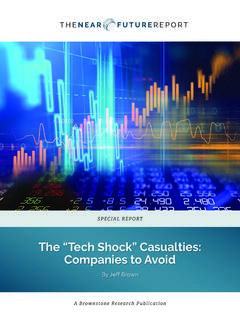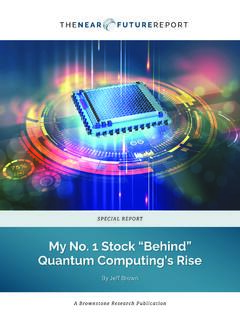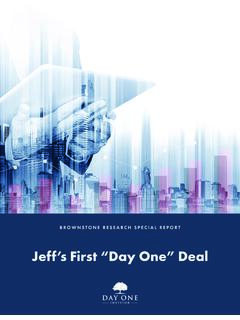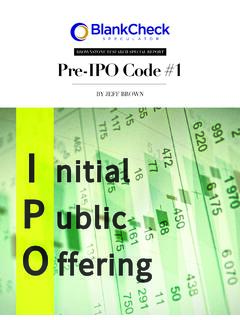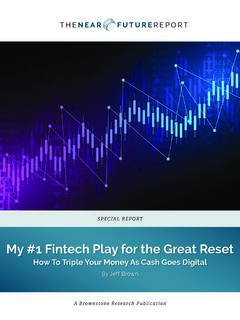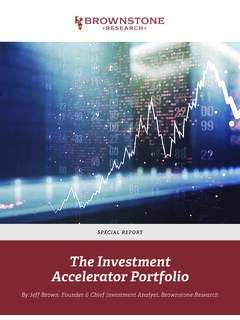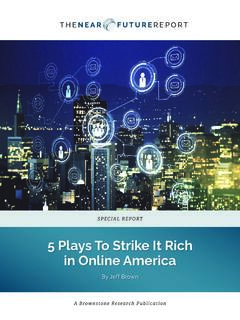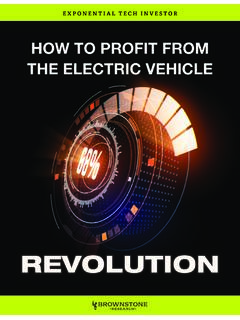Transcription of Your #1 Easiest Way to Profit from the $2.1 Quadrillion ...
1 Your #1 Easiest Way to Profit from the $ Quadrillion World IPO Day By Jeff Brown, Editor, The Near Future ReportSPECIAL REPORTA Brownstone Research Publication2 The Near Future ReportYour #1 Easiest Way to Profit from the $ Quadrillion World IPO Day By Jeff Brown, Editor, The Near Future ReportThe year is 1602 in the city of Amsterdam. And the course of financial markets is about to change This was the year that the world s first publicly traded stock became available for purchase. The company was the Dutch East India Company also called VOC a trading conglomerate believed to have been the largest company to ever exist at that time. Back then, shipping expeditions were typically funded by wealthy, private investors. One shipping expedition is estimated to have cost roughly $300,000 in today s dollars.
2 It was an expensive and risky endeavor. If the ship sunk or was attacked by pirates, investors lost all their money. Worse yet, it could be years before the investors learned of the ship s fate. It was like a 1600 s version of venture capital in that way. Some investments were absolutely spectacular, and many were a complete disaster. To offset this risk, VOC pursued a novel solution. The company issued shares that could be publicly bought and sold on an exchange in Amsterdam. The shares looked something like this: Source: Bruce Fenton Today, we take publicly traded stocks for granted. But at the time, this was revolutionary. For the first time, enterprises could pool capital from everyday people. And it was the first time that ordinary investors could own a portion of a public company and Profit from its it was this event that started the world down a path that would create what we understand today as modern stock markets.
3 Today, we re faced with a similarly momentous event. In the years ahead, we ll still be able to invest in public companies. But that won t be all. Thanks to bleeding-edge technology, anything of value will be able to be publicly traded. Special Report20213 The Near Future ReportImagine investing a few hundred dollars in a vintage Ferrari. Or perhaps we d like to invest a small amount into a new commercial office building. Ever watch the Kentucky Derby? Imagine owning a portion of the winning horse. It s hard for us to wrap our heads around a concept like this. Yet this technology will allow retail investors to invest in assets that have historically been off-limits. I know what we re probably thinking. It sounds impossible. It s not. Here s Welcome to The Near Future ReportWelcome to The Near Future Report.
4 I m thrilled to welcome you as our newest member. Our mission here is to Profit from technology trends that are right around the corner. We do this by identifying sleep well at night technology investments that are still in growth mode. My name is Jeff Brown. I will be your editor. For nearly 30 years, I worked as a technology executive for firms like Qualcomm, NXP Semiconductors, and Juniper Networks. I ve earned degrees from Purdue University and the prestigious London Business School. I ve also received professional certificates from MIT, Stanford, and the University of California, Berkeley, School of Law. I m also an alumnus of Yale University s School of Management. Also, I m an active angel investor in early stage technology companies.
5 As of this writing, I ve invested in 200+ private deals. You might even know some of my private investments. I was a private investor in Coinbase, for instance, the world s largest digital asset exchange that recently went public. I don t mention this to brag. I simply want to emphasize that I m not a typical Wall Street analyst trying his or her hand at technology research. I come from the industry. I ve helped build and turn around technology companies. And I ve devoted my entire life to researching, working with, and investing in bleeding-edge technologies. As I mentioned above, we are on the verge of an innovation not seen since the first public stock was traded in the 1600s. It will change the course of finance forever. And for knowledgeable investors, it will be one of the most lucrative investing trends of our lifetimes.
6 Unlocking the Private EconomyBefore the invention of publicly traded stocks in the 1600s, the market for public equities was, of course, zero. This makes sense. After all, how can there be a market for public equities if the asset class doesn t exist?Flash forward to today and the value of all publicly traded stocks around the world is estimated to be more than $90 trillion. As an asset class, global equities went from zero to almost $100 trillion. Something similar is happening today. But unlike equities which give investors access to a public economy this technology has the potential to also unlock the world s private economy. Consider the following: The value of all commercial real estate in the world is around $ trillion Global residential real estate is estimated to be worth $ trillion The value of all above-ground gold is roughly $ trillion.
7 All physical silver is $ trillion. In 2020, the world s twenty most valuable 4 The Near Future Reportprivate companies were worth a combined $566 billion The global collectibles market is valued at $370 billion Some have estimated the value of all the artwork in New York s Metropolitan Museum of Art could be worth $400 could go on. And the technology I m sharing today has the potential to unlock all this value and make it available to retail investors. World IPO DayThe way this happens is through a process known as tokenization. Tokenization is the process of substantiating a claim of ownership of an underlying asset. In this way, the process is similar to the securitization process we see with public first major difference, however, is that digital tokens as they are known are supported by blockchain technology also known as distributed ledger technology is most often associated with bitcoin.
8 Blockchain technology is what supports bitcoin s decentralized network. And while bitcoin was the first application of blockchain technology, the term is actually a generic one. Popular blockchains today are not only Bitcoin, but Ethereum, Cardano, Solana, EOS, Polkadot, and so on. We can think of blockchain technology like the internet protocols we use every day. Popular applications like e-commerce, email, and streaming content run on top of internet protocols. It is a similar idea with digital assets and blockchain technology. Put even more simply, saying that bitcoin is the blockchain would be like saying Yahoo! is the internet. But while internet protocols can effectively transfer data, blockchain technology is designed to transfer value across a distributed network.
9 One of the most exciting applications for blockchain technology is the tokenization of assets. As I mentioned, the process of tokenization can substantiate and define ownership in that asset. Here s an easy example: When we purchase a Source: Publish0x5 The Near Future Reportpiece of property, like a home, we are typically the sole owner of that asset. Perhaps our spouse will also be on the title to the home, but it typically stops there. But if that property were tokenized, fractional ownership could be conferred to hundreds even thousands of token holders. The value of these tokens would fluctuate just like any other security. If the value of the home increases, the value of the tokens would increase, and the token holders would be able to share in that value is a straightforward example.
10 The reality is that virtually any asset can be tokenized and traded. Real classic Anything that has value will be tokenized and traded on security token if you could own Empire State Building Or Louvre Museum Or 1937 Bugatti Type 57S Hot Rod tokens?That s the world we are headed for. I refer to the trend of tokenization as World IPO Day because virtually any asset of value that holds interest to others will be able to hold its own public offering and begin trading. And these token exchanges will be global they will trade 24/7, and settlement will take seconds rather than , these tokens will be completely liquid. We will be able to buy, sell, and transfer these assets with ease. We can think of it this way: If we own our home, this asset is highly illiquid.
